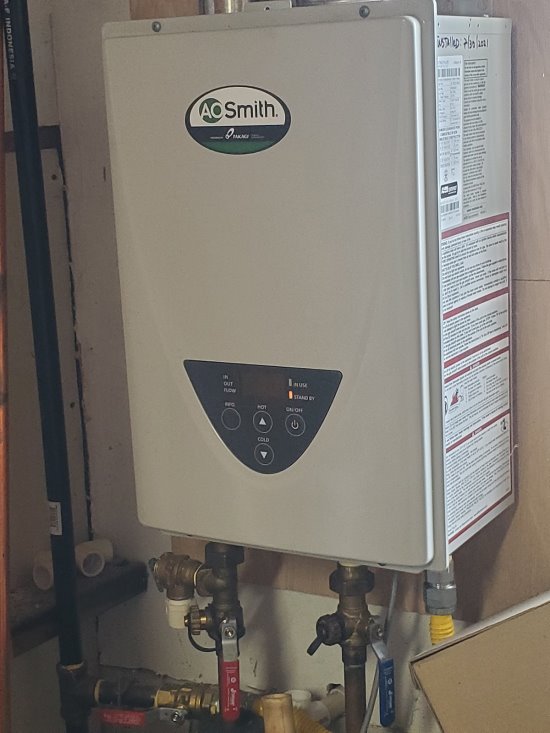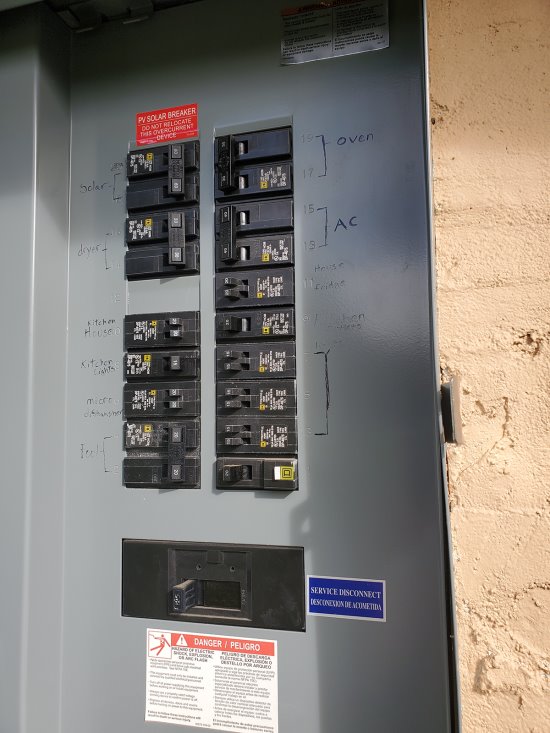 | | | On demand water heater Photos Jim Hurley | | | | | | In Part 1 of the New Home Primer - or things that everyone should know about their house - we covered your water and gas main valves, so now let's go on to locating your water heater. Some homes may have two, which I typically see when a master suite was added as an extension.
 There are two types of water heaters: Tank or On Demand.
There are two types of water heaters: Tank or On Demand.
 Tank heaters have a pilot light which must be lit for them to stay hot. If your hot water is running cold, your pilot light is out. How to relight the pilot? I found several videos on YouTube regarding this process. Also, PG&E provides a pilot light service, if you can't get it lit yourself, but you will have to wait until they get there.
Tank heaters have a pilot light which must be lit for them to stay hot. If your hot water is running cold, your pilot light is out. How to relight the pilot? I found several videos on YouTube regarding this process. Also, PG&E provides a pilot light service, if you can't get it lit yourself, but you will have to wait until they get there.
 Old tanks eventually wear out, and usually the first sign of this is water dripping from the bottom. If there is water dripping from your tank heater, turn off the filler valve above it and get a new heater before the leak becomes a flood.
Old tanks eventually wear out, and usually the first sign of this is water dripping from the bottom. If there is water dripping from your tank heater, turn off the filler valve above it and get a new heater before the leak becomes a flood.
 The tankless, or On Demand water heater is becoming more popular in homes. They are literally high-powered burners that heat the water as it flows through the line when the tap is opened. It never runs out of hot water (unless you forget to pay your gas bill). There is no pilot light because they use electronic ignition, but must have electricity to run. If your On Demand hot water is cold, make sure it's plugged in and there is power at the outlet.
The tankless, or On Demand water heater is becoming more popular in homes. They are literally high-powered burners that heat the water as it flows through the line when the tap is opened. It never runs out of hot water (unless you forget to pay your gas bill). There is no pilot light because they use electronic ignition, but must have electricity to run. If your On Demand hot water is cold, make sure it's plugged in and there is power at the outlet.
 Our last stop in the New Home Primer is your electrical panel, or panels. Find the electrical meter on your home. Open the cover to the box under or beside the meter and look at the breaker switches. One will say "Main." That is the one to switch off if you see sparks, smell smoke, or someone throws a toaster in a bathtub full of water. Depending on your electrical layout, the main breaker panel may have a multitude of additional switches marked with their purpose, or a few larger switches marked as Sub A, Sub B and AC (Air Conditioner). These larger breakers mean you have another (Sub) panel somewhere inside the house with smaller breakers inside. It is very good to locate these boxes, and make sure you can access them when the power goes out in one area of the house.
Our last stop in the New Home Primer is your electrical panel, or panels. Find the electrical meter on your home. Open the cover to the box under or beside the meter and look at the breaker switches. One will say "Main." That is the one to switch off if you see sparks, smell smoke, or someone throws a toaster in a bathtub full of water. Depending on your electrical layout, the main breaker panel may have a multitude of additional switches marked with their purpose, or a few larger switches marked as Sub A, Sub B and AC (Air Conditioner). These larger breakers mean you have another (Sub) panel somewhere inside the house with smaller breakers inside. It is very good to locate these boxes, and make sure you can access them when the power goes out in one area of the house.
 The important thing to know about breaker switches is how to reset them. Most of the time the breaker switch will indicate it has popped when the switch is centered between On and Off. To reset the breaker, move the switch all the way to the Off position then back to On. If it pops again, go back into the house, and unplug any appliances that are near the outlet that is not working. Then try the switch again. If it continues to pop, leave it off until you or your handyman/electrician can locate the short in the circuit. Occasionally an older breaker will pop but the switch will not move back to center. If the power is out in one area of the house, and none of the breaker switches are at center, you will need to click each switch off and then back on to find the one that popped.
The important thing to know about breaker switches is how to reset them. Most of the time the breaker switch will indicate it has popped when the switch is centered between On and Off. To reset the breaker, move the switch all the way to the Off position then back to On. If it pops again, go back into the house, and unplug any appliances that are near the outlet that is not working. Then try the switch again. If it continues to pop, leave it off until you or your handyman/electrician can locate the short in the circuit. Occasionally an older breaker will pop but the switch will not move back to center. If the power is out in one area of the house, and none of the breaker switches are at center, you will need to click each switch off and then back on to find the one that popped.
 The electrical code requires that circuit breakers be labeled by purpose, (Lights, Plugs, Refrigerator, Disposal, Etc.). Some but not all electricians will conscientiously identify which switch controls what area of the house. However, you should never assume that the labels are correct. If you are working on circuit, always verify that the power is off at the junction box, despite what the breaker label says.
The electrical code requires that circuit breakers be labeled by purpose, (Lights, Plugs, Refrigerator, Disposal, Etc.). Some but not all electricians will conscientiously identify which switch controls what area of the house. However, you should never assume that the labels are correct. If you are working on circuit, always verify that the power is off at the junction box, despite what the breaker label says.
 My fervent wish is for everyone to enjoy many trouble-free years in their new homes. But the dad in me says it doesn't hurt to be prepared for emergencies. You never know.
My fervent wish is for everyone to enjoy many trouble-free years in their new homes. But the dad in me says it doesn't hurt to be prepared for emergencies. You never know. |


